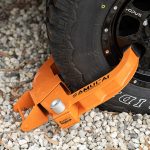The Importance of Retail Theft Prevention
Retail theft is a major issue for stores of all sizes. Losses from theft can cut deeply into profits. This makes preventing theft a key focus for retailers. Anti-theft tags play a crucial role in this area. They serve as a strong deterrent against shoplifting.
The use of anti-theft tags can reduce the occurrence of theft significantly. They are small and often go unnoticed by customers. But they are highly effective in preventing merchandise from being stolen. They work by triggering alarms when someone tries to take tagged items out of the store without paying.
Investing in anti theft tag systems is not just about stopping theft alone. It also helps in maintaining inventory accuracy. Stores can keep better track of their items. It ensures that products are available for legitimate customers when they want to buy.
Aside from safeguarding assets, these tags also protect a store’s reputation. Frequent theft can signal poor security measures. Customers prefer shopping in environments where they feel safe. Effective theft prevention strategies like anti-theft tags make this possible. They help in creating a secure and welcoming environment for shoppers.
Therefore, implementing anti-theft tag systems is essential for any retail business. It ensures the safety of products, maintains store reputation, and reduces financial losses. Retailers must consider the right type of anti theft tag that suits their needs. They should invest in quality systems to deter theft effectively. This is where different types of anti-theft tags come into play.
Types of Anti-Theft Tags and How They Work

Retail security hinges on several types of anti-theft tags. Each type has a unique operation.
Radio Frequency Identification (RFID) Tags
RFID tags work by using radio waves. They contain information on the product they are attached to. Scanners read these tags at checkout or exit points. If not deactivated, the tags trigger an alarm. They are common in clothing and electronics stores.
Acousto-Magnetic (AM) Tags
AM tags emit a specific frequency when a scanner detects them. These tags are typically flat and can be stuck onto products or their packaging. Like RFID tags, they set off alarms if not properly handled at checkout. AM tags are useful in protecting a wide range of merchandise.
Electromagnetic (EM) Tags
EM tags are distinct because they can be deactivated and reactivated. Bookstores often use them due to their slim profile. They have a strip that becomes magnetized if not demagnetized at the point of sale. This magnetization causes the store’s security system to sound an alert. EM tags are a discreet option for safeguarding goods.
Implementing an Effective Anti-Theft Tag Strategy
To protect merchandise and profits, retailers need a solid anti-theft tag strategy. An effective plan does more than deter theft; it aligns with the store’s operations and customer service goals. Creating a seamless integration of anti-theft measures can enhance overall store security without impacting the shopping experience negatively.
First, identify the types of products that are at high risk of theft. These typically include small, high-value goods that are easy to conceal. Once identified, choose the appropriate type of anti-theft tag—RFID, AM, or EM—based on the product type and the store’s infrastructure.
Training staff is crucial for the success of any anti-theft tag system. Employees must know how to properly tag items, handle deactivation at checkout, and respond to alarms. Regular drills and updates on shoplifting trends can keep staff alert and prepared.
The placement of scanners and deactivation devices is equally important. They should cover all exit points and be positioned to minimize false alarms. This helps preserve a positive shopping atmosphere and avoid inconveniencing customers.
Anti-theft tag systems should undergo regular maintenance to ensure they are functioning correctly. Checks and updates can prevent technical failures that might leave merchandise unprotected.
Finally, continually evaluate the effectiveness of the anti-theft tag strategy. Analyze theft incidents to adjust measures as needed. Retailers may find the need to upgrade their systems or change tagging practices if theft patterns change.
Implementing an effective anti theft tag strategy requires regular review and adaptation. By understanding the dynamic retail environment, stores can maintain security while delivering a positive customer experience. And with the right combination of technology and best practices, retailers can significantly reduce the impact of theft on their business.
The Role of Technology in Modern Retail Security Systems
Technology has reshaped the landscape of retail security. Modern systems integrate seamlessly with the day-to-day operations of a store. Anti-theft tags are a core component of these systems. They showcase the use of technology to combat theft efficiently.
The foundation of anti-theft technology relies on detection and deactivation devices. These systems are designed to recognize tagged merchandise. They alert staff if someone tries to exit the store without paying. This technology acts as a deterrent. It can also collect data on attempted thefts. This data is vital for understanding theft patterns.
Scanners play a key role in detecting anti-theft tags. They use radio waves or magnetic fields to sense tagged items. When the systems pick up a signal from an active tag, they trigger an alarm. This process underlines the importance of maintaining a good line of sight. Scanners must be placed strategically around the store. They should have a clear path to detect any tagged item leaving the premises.
Deactivation devices are equally important. They ensure a smooth customer experience. At the checkout, staff use deactivation devices to turn off or remove tags. This prevents false alarms. It also highlights the significance of training employees. They need to handle all aspects of anti-theft tags quickly and effectively.
Lastly, integration with other store systems enhances retail security further. Inventory management systems can work with anti-theft tags. This allows for real-time tracking of merchandise. Retailers gain insights into stock levels and movement within the store. This integration makes anti-theft tags multi-functional. They protect against theft and contribute to efficient store management.
The combination of these technologies forms a strong defense against retail theft. Retailers can deter crime while keeping the shopping experience pleasant for customers. Investing in modern security systems is key for any retailer looking to stay ahead in safeguarding their assets.
Best Practices for Tagging Merchandise

Proper tagging is crucial to maximize the effectiveness of anti-theft tags. Here are the best practices for tagging merchandise in retail settings:
- Position Tags Strategically: Place anti-theft tags on products where they are least likely to be tampered with. This often means choosing hidden yet accessible areas on the merchandise.
- Use the Right Tags: Match the type of anti-theft tag (RFID, AM, or EM) with the item’s properties. Electronics may need RFID tags, while books may benefit from EM tags due to their thin profile.
- Secure Tags Firmly: Ensure that tags are attached securely to prevent easy removal. This could involve using strong adhesives, ties, or bespoke tagging solutions that are hard to cut or dismantle.
- Maintain Visibility: While you don’t want tags to be easily removed, they should be visible enough to serve as a deterrent to potential thieves. The presence of an anti-theft tag can dissuade theft attempts.
- Train Staff Effectively: Employees should be knowledgeable about how to tag items properly and handle deactivation at the checkout. Regular training sessions are important for keeping staff up to speed with tagging procedures.
- Regularly Audit Tagging Practices: Periodically, review your store’s tagging practices to ensure that protocols are being followed and that tagging remains effective against evolving shoplifting methods.
By implementing these best practices, retailers can enhance the security of their merchandise. Anti-theft tags, when used correctly, can serve as a potent tool in the fight against retail theft, ensuring that stores maintain their profitability while providing a safe shopping environment.
The Impact of Anti-Theft Tags on Customer Experience
The presence of anti-theft tags in a retail store has a dual effect on customer experience. On the one hand, customers perceive a secure shopping environment as a result of anti-theft measures, which can improve trust and satisfaction. On the other hand, if not managed properly, the tags can lead to inconvenience and frustration for shoppers. Here’s how to balance security with customer experience:
- Ensure Quick Checkout Processes: Deactivate anti-theft tags efficiently to minimize wait times at checkout, preventing annoyance among customers.
- Minimize False Alarms: Accurate deactivation reduces the occurrence of false alarms. False alarms can embarrass customers and disrupt the shopping atmosphere.
- Discreet Tag Placement: Strategically place anti-theft tags to be less intrusive, allowing customers to examine and try products unencumbered.
- Transparent Communication: Inform customers about the anti-theft systems in place. Clear signage can explain the purpose of tags and reassure customers about the store’s safety measures.
- Customer Service Training: Train staff to assist customers quickly if alarms trigger accidentally. Immediate and courteous resolution maintains a positive experience.
By considering these points, retailers can use anti-theft tags to not only secure their merchandise but also maintain a pleasant shopping environment for their customers. Anti theft tag strategies must, therefore, be designed not only with loss prevention in mind but also the overall satisfaction of the legitimate customers who visit the store.
Understanding Anti-Theft Tag Deactivation and Removal

Deactivating and removing anti-theft tags is a critical step in retail operations. It ensures a hassle-free shopping experience for customers. Let’s dive into the best ways to handle these processes.
Efficient Deactivation at Checkout
To keep checkout lines moving, swiftly deactivate tags. Use reliable deactivation devices that align with the type of anti theft tag used. For RFID and AM tags, staff should pass items over a deactivation pad. For EM tags, a demagnetizer should be used. It’s vital to test tags to confirm deactivation before a customer leaves the store.
Secure Tag Removal
Some tags require removal instead of deactivation. This applies to hard tags typically found on clothing or high-value goods. Staff must remove these tags with a specialized detacher. Position detachers at every checkout to ensure quick service. Training staff in their use is essential to prevent delays and damage to merchandise.
Handling Alarms after Purchase
Sometimes, tags are not deactivated or removed correctly. This leads to alarms going off as customers exit. Train staff to respond to these incidents fast and with a friendly approach. They should check receipts, deactivate or remove the missed tag, and apologize for any inconvenience.
By mastering tag deactivation and removal, stores will improve customer flow and satisfaction. Staff competency in these areas is key. It avoids frustration at checkout and preserves the store’s reputation for efficiency and service excellence.

